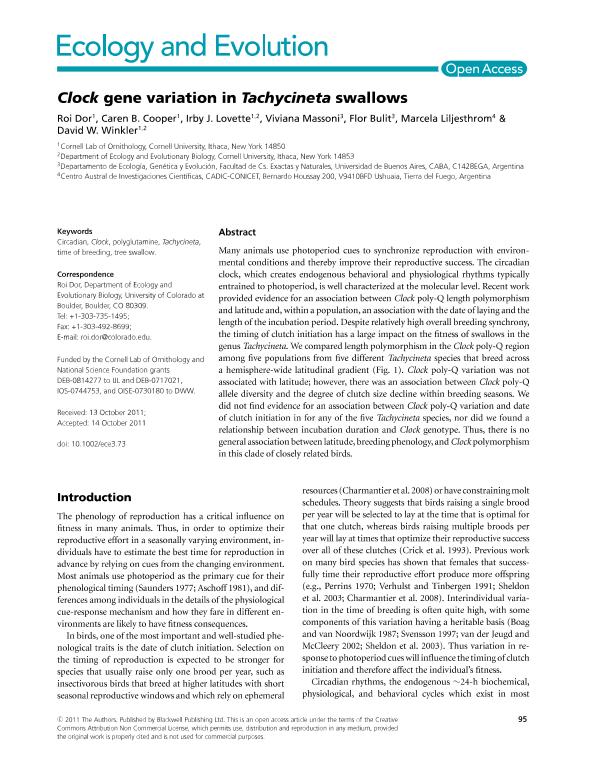Artículo
Clock gene variation in Tachycineta swallows
Dor, Roi; Cooper, Caren B.; Lovette, Irby J.; Massoni, Viviana ; Bulit, Florencia
; Bulit, Florencia ; Liljesthrom, Marcela
; Liljesthrom, Marcela ; Winkler, David Ward
; Winkler, David Ward
 ; Bulit, Florencia
; Bulit, Florencia ; Liljesthrom, Marcela
; Liljesthrom, Marcela ; Winkler, David Ward
; Winkler, David Ward
Fecha de publicación:
01/2012
Editorial:
Wiley
Revista:
Ecology and Evolution
ISSN:
2045-7758
Idioma:
Inglés
Tipo de recurso:
Artículo publicado
Clasificación temática:
Resumen
Many animals use photoperiod cues to synchronize reproduction with environmental conditions and thereby improve their reproductive success. The circadian clock, which creates endogenous behavioral and physiological rhythms typically entrained to photoperiod, is well characterized at the molecular level. Recent work provided evidence for an association between Clock poly‐Q length polymorphism and latitude and, within a population, an association with the date of laying and the length of the incubation period. Despite relatively high overall breeding synchrony, the timing of clutch initiation has a large impact on the fitness of swallows in the genus Tachycineta. We compared length polymorphism in the Clock poly‐Q region among five populations from five different Tachycineta species that breed across a hemisphere‐wide latitudinal gradient (Fig. 1). Clock poly‐Q variation was not associated with latitude; however, there was an association between Clock poly‐Q allele diversity and the degree of clutch size decline within breeding seasons. We did not find evidence for an association between Clock poly‐Q variation and date of clutch initiation in for any of the five Tachycineta species, nor did we found a relationship between incubation duration and Clock genotype. Thus, there is no general association between latitude, breeding phenology, and Clock polymorphism in this clade of closely related birds.
Palabras clave:
Circadian
,
Polyglutamine
,
Time of Breeding
,
Clock
Archivos asociados
Licencia
Identificadores
Colecciones
Articulos(CADIC)
Articulos de CENTRO AUSTRAL DE INVESTIGACIONES CIENTIFICAS
Articulos de CENTRO AUSTRAL DE INVESTIGACIONES CIENTIFICAS
Articulos(IEGEBA)
Articulos de INSTITUTO DE ECOLOGIA, GENETICA Y EVOLUCION DE BS. AS
Articulos de INSTITUTO DE ECOLOGIA, GENETICA Y EVOLUCION DE BS. AS
Citación
Dor, Roi; Cooper, Caren B.; Lovette, Irby J.; Massoni, Viviana; Bulit, Florencia; et al.; Clock gene variation in Tachycineta swallows; Wiley; Ecology and Evolution; 2; 1; 1-2012; 95-105
Compartir
Altmétricas



